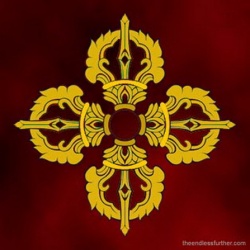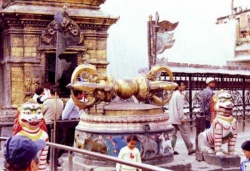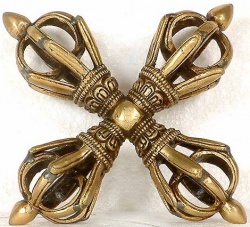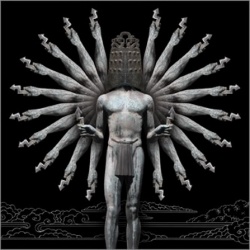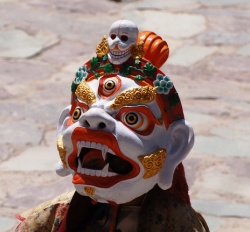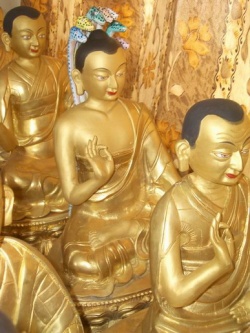The Vajra as Implement, Emblem and Symbol
The Tibetan ritual implements coming next (after this) on our itinerary are not just artistic representations to be ‘read through’ to the high religio-philosophical matters of which they are, in some in-truth mysterious way, both medium and indication, only to be then dispensed with; they are objects in their own right, not just stand-ins for something else. Neither were they meant to lay immobilized as ‘objects’ in museum display cases, however justifiable this might seem from an aesthetic or ethnological point of view. They are supposed to do things. One thing they do is ‘mark’ deities, telling those who are versed in iconography their identity. In this iconographical context (and occasionally in ritual contexts as well) they are called, in Tibetan, chagtsen (phyag-mtshan), literally, ‘hand-signs’ (or perhaps more simply ‘marks’), or less literally yet preferably, ‘emblems.’ They are also instruments for performing a broad range of ritual actions. They might in truth be called the ‘tools-of-trade’ of most every Tibetan religious specialist.[1]
In ritual texts, they are usually called lagcha (lag-cha, literally, ‘hand-piece’ and less literally yet certainly ‘tools’), although they might be subsumed under broader categories like yojé (yo-byad, ‘requisite items’), Damdzé (dam-rdzas ‘sacred commitment substances’) or damtsiggi yenlag (dam-tshig-gi yan-lag, ‘sacred commitment appendages’). These latter categories include a large number of the concrete items employed in the course of the ritual, and not just the implements as such, but even substances intended as offerings and/or sacraments. While a great variety of these items may be ‘required’ in the conduct of a particular ritual, this does not mean that they all need to be visible to the eye of an innocent bystander. The items employed in tantric rituals are very frequently mentally transformed (or as the ritual texts also say, ‘generated’) into much bigger or more elaborate versions of themselves, or even at times into something else altogether.
Consulting the Tibetan text that describes a monastic ritual, the newcomer to a Tibetan monastery in India or Nepal may be surprised to see that the throwing of flowers called for in the text has turned into the throwing of rice in the ritual performance (barley corns were used for this purpose in old Tibet). This is no problem to the monk participating in the rite. For them the grains of rice are flowers, and are conceived of as such. Some ritual requisites might be difficult or impossible to procure. If the ritual handbook calls for an elephant to be present, to give one real example, Tibetan ritual officiants would most likely not do like Hannibal and bring an elephant over the mountain passes from India and try to squeeze it through the temple doors. Rather they would make use of a ritual ‘flash-card’ (called tsa-ka-li) with a picture of an elephant while they conceive in contemplation the presence of an actual elephant.
In some, or even many cases the contemplative conception of the item is considered sufficient, and no external representation is needed. Ritual implements likewise may on some occasions be substituted with flash-cards or other illustrations,[2] or they might be generated in the mind of the contemplative. Vajras, for example, are very frequent in visualization practices that were never even intended to be ‘acted out’ externally in a ritual. Clearly the boundaries between contemplative visualization and concrete ritual action are and probably always have been open to a certain amount of re-negotiation. Although it would, it is true, be highly desirable to record all the ritual, liturgical and contemplative contexts in which each implement occurs, in what follows we will have to be content with some occasional and limited indications of ritual utilization. The Tibetan ritual world is vast, exceedingly complex, and does not lend itself to fast and easy encapsulation. I have no hope of knowing everything about it in this life.
Furthermore, all these things belong to the realm of esoteric ritual. They are ‘secret,’ although this word requires some comment. ‘Secret’ belongs to the traditional triadic classification system of outer, inner and secret. Here I offer little more than a superficial description of outer appearances (as well as historical developments in the same) and a few glimpses into the interior symbolic aspects. These inner aspects are for the most part not my own intuitions (or theoretical deductions), but those of my Tibetan or, less often, Indian authorities. These same authorities have their own standards of what may be expressed in language and divulged in books with black letters. To go beyond these would be to break the ‘bonds’ (dam-tshig) of the relationship between the Vajrayānists and the divine image of their high aspirations or, which is to say practically the same thing, between the Vajrayānists and their lineages of teachers.
The rule to be followed here is never to use the words ‘it is nothing but,’ but to remain open to as-yet unsuspected meanings. Given the requirement of prior experience, ‘secrets’ are such because they keep themselves secret from those who are not well enough prepared to see what’s there. Secret-ness, too, is the very platform on which revelations are made. Without secrecy there would be no mystery, without hiddenness or mystery, no revelation. I think that mystification, meaning secrecy for its own sake or for self-aggrandizement, if not entirely absent, was not the usual motive. (Craft guilds’ trade secrets may be another matter.) Anyway, no secrets will be told here, and none should be expected. We will deal with sources that are already public, and in most cases published. I fear some will become impatient if everything doesn’t become entirely transparent all of a sudden, once and for all. If you are like that you will soon be disappointed. But if you are ready to go on, well, let’s get started.
The Vajra, together with its counterpart the Bell is, of all the various symbolic implements used in Tibetan Buddhist ritual, iconography and literature, the most significant from several perspectives. It is precisely its pervasiveness within the tradition of tantric Buddhism[3] which is most frequently identified by the name Vajrayāna, ‘the Vehicle of the Vajra,’ that make its meanings so difficult or impossible to pin down with any grand illusions of simplicity. It will be very important for readers of the following comments to distinguish our contemporary historical constructions from Buddhist, both Indian and Tibetan, understandings and usages. Here, as is so often the case, the meanings we find through historical tracing and etymology may have little to do with (or may on occasion, even if not here, directly contradict) the understanding of the particular religious culture that actively employs the symbolic item. Origin is, after all, not necessarily destiny.
In this place we would rather give greater weight to interpretations found in Tibetan-language sources, since for Tibetan Buddhists these things are very much part of a living world of tradition, and as such demand respect. Furthermore, Vajrayāna may be defined quite simply as Buddhism of the esoteric kind; ‘esoteric’ because it requires initiation and a personal relationship with a lineage holder, as well as personal experience of that which is symbolized (to translate this into plainer English: Those who demand a full and fully genuine comprehension of the symbolism might do well to stop reading this and instead pursue the traditional methods). While the simpler aim here is to find explanations — preferably not made up explanations — that are historically demonstrable (or disprovable, or at the very least traceable) and intellectually satisfying, these explanations should also be tested for their resonance with the general realm of Things Buddhist and Things Tibetan.
It is usual to understand the Vajra to mean originally a thunderbolt, while Tibetan Buddhists understand it to mean ‘adamant’ or ‘diamond.’ Often Tibetans have simply transcribed the word Vajra into their own alphabet as Badzra (Ba-dzra), but the Tibetan translation for Vajra is Dorjé (Rdo-rje), which might be etymologically analyzed as ‘Stone’ (rdo) ‘Lord’ (rje), an epithet for the diamond, Lord of Stones.[4] As we will see, the symbolic significances of Indra’s weapon (which may or may not be precisely or exclusively a thunderbolt) and of the diamond are united by the qualities of hardness and durability.
It is certain that the first mentionings, about two hundred and seventy-five in all, of something called a ‘Vajra’ occur, very approximately four thousand years ago, in the then-oral text of the Rig Veda as a hand-held weapon of the god Indra.[5] Even if commonplace, the statement that this Vedic Vajra is a thunderbolt excites controversy. Its identity as a thunderbolt may be at least in part a product of nineteenth-century comparativists who preferred to find natural (and therefore universal) phenomena behind mythological items.[6] Most twentieth-century Indologists[7] see Indra’s Vajra as an at least partially metallic — gold, copper or iron — instrument along the lines of a hammer, axe or club (or even, according to one not very well received suggestion, a harpoon[8]) which Indra kept always in hand. It is sometimes said to have a thousand knots or a thousand edges.[9] The Vedic Vajra might be thrown at the enemy and made to rotate in its flight, or used in hand-to-hand combat in order to cut like an axe or smash like a club. It was made up of a wooden shaft tied to the metallic head with a kind of twine.
It is interesting that there are passages in the Rig Veda that describe the Vajra-weapon as ‘stable’ and ‘durable,’ since these words could equally apply to the Tibetan understanding of the Vajra as a diamond. Another scholar of Vedic studies[10] has connected the Vajra to some rather large (one to two hand-lengths in size) copper instruments found in Indian archaeological sites which have two sharpened prongs extending outward forming a ‘V’-shape. In their appearance, they are somewhat anthropomorphic (and hence called ‘anthropomorphic figures’ in archaeological works), with the extended prongs looking like outspread human legs.
Anthropomorphic Figure, so-called
These might have originally been attached to a wooden shaft to form an instrument for striking.
Regardless of these speculations, I think it was a weapon for battle. It may be that some more obvious metaphors for war, the gathering storm cloud of soldiers with lightning-like weapons, came to the foreground as time went by. Battle imagery is always being used for peaceful purposes. Poetry has no problem plowing with metaphorical weapons.
The other types of instruments that we will look at now are, unlike the Vedic weapon, not meant to be held by an attached handle. They are rather ‘scepters’ in form, relatively small at the center where they are most usually held, and with each of the two ends being a mirror image of the other. This type of Vajra is found, with more or less minor variations, in all the ‘Northern’ Buddhist countries as well as in medieval Indian art. Although there are many problems that cannot all be addressed here, it is most probable that the form of this Buddhist and Indian Vajra had its transmission from Greece by way of the Middle East, perhaps as early as the Hellenistic Period. The medieval Indian and Tibetan (and Silk Route, Japan, etc.) Vajra is strikingly similar to the Keraunos held by Zeus in Greek art. Behind the shape of the Keraunos may be still earlier Mesopotamian and Hittite representations of lightning held in the hands of depicted deities.[11]
Weather God Hadad at Gaziantep, Turkey
(I believe the photo has been reversed)
It may not be at all obvious that our usual contemporary representation of the lightning bolt as a (usually single) zig-zagged line is itself a cultural product that was not even in use just three hundred years ago.[12] The oldest recognizable human representations of lightning in Middle Eastern history (ranging from about 2000 to 1000 bce) are rather fork-shaped, with two or three long and wavy tines.[13] It was in about 1000 bce that lightning became most commonly represented in a similar manner, but having a double-ended form that begins to approach the form of the Tibetan Vajra. In another century or two, the central tine became straight and tapered to a point, while the tines on either side tended outward, often in a form reminiscent of the horns of an ox. This is the typical form of the Greek Keraunos.
Detail from an ancient Greek vase
It is tempting to see this Greek divine weapon of Middle Eastern origins as the source of transmission of the Buddhist form of the Vajra, given their obvious similarities that have often been noticed.[14] The main differences are not in the major outline but in the details. Where the outer prongs of the Keraunos bend outward, they always turn inward toward the central prong in the Tibetan versions, and very often touch it, as we will see. The shaft (including the central prongs) of the Keraunos often has a spiralling incision in it, while they may or may not have something like the rounded bulge at the center that is always seen in the Tibetan Dorjé.
The main problem that confronts us is how to account for the transmission from Greece to India and beyond. The logical time and place for us to look is the Gandhāran art of the early centuries ce. It was in Gandhāra, in the area of modern northern Pakistan, that the Buddha image was produced under strong Greek artistic influences (even if the Buddha image might have originated, as many Indian scholars argue, in the city of Mathurā in northern India). The Vajra does exist in Gandhāran Buddhist art, but in a form that does not very closely resemble either the Keraunos or the Indian and Tibetan Vajra. The Gandhāran Vajra looks like a plain, solid squared beam about the length of the forearm of the figure bearing it, only attenuating at the center where it is held.[15] This very different form makes it impossible to claim that this apparent Greek influence reached Indian Buddhism by way of Gandhāra. This leaves us still in the dark about a particular route of transmission that would explain the similarities of the Keraunos and most non-Gandhāran Buddhist Vajras.
To briefly summarize, we may say that while the Vedic Vajra weapon seems to have had a form of some kind of club or axe with an attached handle, the Buddhist Vajra has its particular form because of influence, at some as yet not precisely specified time, by way of the Middle East, or very possibly by Greeks residing in areas to the northwest of India. Even given the likelihood that this historical picture is basically defendable or even simply true, we still haven’t gained much idea about what the Vajra means in Buddhism, and more particularly in the Buddhism of Tibet, which is pervaded by the tantric form of Mahāyāna (‘the Great Vehicle’) known as Vajrayāna (‘the Vajra Vehicle’).
[1] One way of thinking about these weapons/tools, in Sanskrit āyudha, is from the perspective of the one who makes them, the traditional Indian artisan. From this point of view, the making of tools requires tools, and there is the ever-present danger that the artisan may be injured by the very tools required in the creative process. This entails a cult of tools, in which the tool, often more or less identified with a deity (or the ‘weapon’ of a deity), requires ritual propitiation. More material for thinking along these lines may be found in Brouwer (1988). Risking banality, we might dryly note that these tools, however divinized they may be, are necessary for the construction of divine images.
[2] I have in my personal library copies of two different woodblock prints of ‘substitution drawings’ (dod ris [this does not mean just ‘representation’!]) of items that tantric initiates ought to have in their possession. One of the two texts, printed on a single long folio, was acquired in 1993 at the monastic printery of Sera Monastery near Lhasa in Tibet. The other is a photocopy of a seven-folio print originating from Kumbum (Sku-’bum) Monastery in Amdo, northeastern Tibet, probably in the 19th century (from the personal library of Thubten J. Norbu, former abbot of Kumbum), which in its colophon mentions two still earlier versions. Illustrated in both are a wide variety of tantric requisites, including Vajra, Bell, Bone Ornaments, drums, rosaries, Bodhisattva ornaments, skullcups, fire offering implements, ritual vases, animal hides, ropes, snares, hooks, choppers, swords, banners, and still more. The Sera print is quite similar, down to the details, to the more artistically rendered Sku-’bum version. In both versions, the first two implements illustrated are, quite properly, the Vajra and Bell.
[3] All the Tibetan sects accept tantra in its Buddhist form, even while simultaneously continuing to revere and practice non-tantric forms of Buddhism. This distinguishes Tibet from other ‘Northern’ Buddhist countries such as China and Japan where tantric texts, rituals and ideas tended to be made the exclusive preserve of separate tantric schools. I leave discussion of the Bon school and the similarity of their chags-shing sceptre with the vajra for another occasion.
[4] In order to refer without ambiguity to the mineral substance ‘diamond,’ Tibetans use the word pha-lam or, very often, rdo-rje-pha-lam (a compound of near-synonyms). It has been suggested that the specific meaning ‘diamond’ is also reflected in the use of the word vasira in a Khotanese text, which might imply a route of influence, although the time and reasons for the linkage of the concept of ‘diamond’ with the Vajra remain, in my opinion, obscure (see Gibson 1997: 50). It may be worthy of note that the verbal root behind the Sanskrit form vajra is vaj, which generally means ‘to go, move, roam about,’ a meaning not very well suited to diamonds, but fully appropriate for a self-propelling magical weapon.
[5] See Chakravarty (1997: 96); Kumar (1996). In the Iranian Avesta, the vazra is a weapon used by the god Mithra. Earlier artistic representations of Indra in India do not bear anything that might correspond to the Vajra. These Hindu Vajra representations seem to make their first appearance in in art of the 10th to 12th centuries in a form quite similar to Indian Buddhist and Tibetan Vajras (Devendra 1965: 130-131). In other words, Indian Buddhist artistic representations of pronged Vajras seem to occur before Hindu representations of Indra with a Vajra. Some have perceived the earliest artistic occurrences of Vajras in decorations for early Buddhist stūpas at Sanchi and Bharhut (see Banerji 1980: 171), but then again, while these are surely identifiable as Vajras (especially when seen in the hands of the Buddhist form of Indra!), they do not yet have the familiar shape (see drawings in Sivaramamurti 1949: 22-23, figs. 2 a-d and 3 a-b). These statements should not be considered to be anything more than tentative. Dkon-mchog-bstan-’dzin (1994: 312-313) tells a story, evidently of Puranic Hindu origins, of how the first Vajra used by Indra was made from the footbone of a sage (rishi) named Curd Drinker (Drang-srong Zho-’thung). This is none other than the Sage Dadhīka, discussed by Giuliano (2008), with the story briefly told in Granoff (2009: 61). According to this context, the Vajra weapon could not be harmed by any other weapon. It would throw itself at all who showed ill will, hit anyone at whom it was thrown, kill anyone it hit, and guide to liberation whoever it killed. There is more on the Puranic sources in Agocs (2000: 65-67), and for Epic sources, see Whitaker (2000). Of course in more recent times the Vajra came to be held in the hands of other Hindu deities besides Indra, and was used in Jaina iconography (Banerji 1980).
[6] One may note the remarks on the symbolism of the Vajra by Guenon (1962/1995: 121-128, 224-5) and Snodgrass (1992: 174-177), which are both comparativist and universalist, but in the area of metaphysics or cosmology rather than ‘nature’ per se (which is not to deny the particular information that is to be found in these and other writings by the same authors). We wouldn’t pretend to entirely escape the perils of comparativism here, but it is our main aim to find and convey particular, and particularly Tibetan, understandings of the symbolism, whenever possible. ‘Nature’ and ‘the universe’ will be given their due when warranted by the sources. I see little reason for polemic against the ‘traditionalist’ school largely inspired by René Guénon, including in particular the Bostonian art historian Ananda Coomaraswamy, or for that matter against the ‘history of religions’ school from Mircea Eliade, except for the fact that they tend to universalize ahead of time, before letting traditional particularities of culture and locale, not to mention history, have their say (on Eliade’s pan-Babylonianism, see the critique by Korom [1992], which also contains pertinent remarks about the comparative enterprise). In any case, we should probably remind ourselves constantly of the human tendency to approach dialogue by first creating ‘linkages,’ in particular etymologies (and apparent linguistic cognates) both false and supportable, as a method of developing rapport, which might then be used to promote a sense of common cause in political or other fields. This etymological method is by no means limited to word-history, but to other aspects of history as well, including artifacts and, yes indeed, symbols. (Consider for a moment the not entirely hypothetical but nevertheless truly preposterous example of European [neo-?]Nazis seeking to create linkages with Chinese Buddhists or Tibetan Bonpos on the basis of one supposedly ‘shared’ symbol.) Seeing our own sacred symbolism in use in another culture produces a shock of recognition that can as quickly be followed by a shock of non-recognition (like an Israeli seeing a Star of David [Magen David, widely known as the Seal of Solomon] in use in a Newari or Tibetan Buddhist ritual, for example). Certainly if there is anything ‘to’ the universality of symbols, it isn’t in the symbolic forms themselves, but rather in that which they might serve to symbolize. The very strong Buddhist insistence on the Bodhisattva ideal of helping everyone under the motivation of the universally applied emotions of love and compassion ought to preclude the very possibility of its symbols being appropriated by persons who live on hatred of the ‘other.’ Still, the world is a confused and confusing place, and, as a quick internet search may reveal, just such appropriations are taking place at this very moment.
[7] See Apte (1957), for example.
[8] Kumar (1996) supports this idea.
[9] Chakravarty (1997: 97).
[10] Gupta (1975). Gupta’s suggestion about ‘anthropomorphic figures’ being identifiable with the ancient Vajra has not been especially well received (see for example Smith 1979).
[11] Smith (1962) shows how an iconographical form of Zeus, which he calls the ‘Striding Zeus,’ derived from Middle Eastern sources. In this form, Zeus wields a Keraunos in the right hand as if ready to hurl it at an (absent) opponent (many examples in Cook 1925: 740 ff.; for arguments about historical transformations in the shape of the thunderbolt starting from the ancient Near East, see the same work, pp. 764-785). For a 1st-2nd century Roman example that appears to be walking, yet holding the Thunderbolt in a resting position, see Polichetti 2010.
Striding Zeus
wielding a Keraunos
The ‘Striding Zeus’ bears a striking artistic resemblance to some depictions of Vajrapāṇi (for examples, see especially Santoro 1979). According to Cook (1925: 722), the thunderbolt is the most frequent attribute of Zeus from the 6th century BCE onward, although he also argues that its importance gradually waned in subsequent centuries. Generally the thunderbolt would be held in the right hand, whether or not it was wielded above the shoulder level, and the left hand might be extended straight out to form a perch for an eagle (often missing in the surviving examples; this latter attribute has no visual analogue in Tibetan art, but perhaps it has an elusive mythic analogue in the relationship between Vajra Wielder and the garuḍa bird).
"Vajra Man" in the Jokhang, after Schroeder
Intriguing, too, in this regard are depictions of a Vajra Man (Vajrapuruṣa), with a half-Vajra emerging from his head, in reliefs found in Nagarjunakonda, in Andhra, South India (see Giuliano 1998). Anthropomorphized weapons are quite frequent in Indian religions and certainly date back at least as far as the 5th century or so CE, since they are mentioned by the famous Indian poet Kālidāsa (see Agrawala 1964 for a study of the humanized forms of Viṣṇu’s weapons, but see also Agrawala 1965: 211-212). The Vajra Man makes an appearance also in the carved wooden lintels of chapel doors in the Jokhang, which may date from the 7th century (Schroeder 2001: I 429, 474-477). One author (Vajracharya 2004: 44) suggests that we ought to locate the origins of humanoid weapons (āyudha puruṣa) in the classic textbook of Indian drama, the Nātyaśāstra, which says that separate actors should represent and bear the attributes and vehicles of the deity. This solves a problem of stagecraft, since deities could not be so easily represented on stage with all their multiple hands, or actually riding on their accustomed vehicles.
In Gandhāra, we find some images of Vajrapāṇi that incorporate aspects of the iconography of Hercules, such as the use of lion-skin clothing (and otherwise near-nudity). The club of Hercules was replaced with the Gandhāran form of the Vajra (illustrated in Mustamandy 1997: 24, fig. 4), which is itself relatively club-like. For a fascinating comparative study of Vajrapāṇi and Hercules, see Flood (1989). For a very impressive collection of artworks inspired by Hercules, see this page.
[12] Wilk (1992).
[13] The tines might also be ‘zig-zagged,’ but with the zig-zags formed entirely of obtuse angles. One may easily observe from viewing actual thunderbolts, that they tend to fan out into a fork-like pattern as they approach the ground. The Hittite storm god holds a lightning symbol, composed of three wavey tines emerging upward from the closed fist of his left hand, an axe wielded high in his right (see Hawkins 1992 for illustrations).
[14] See especially Blinkenberg (1911: Chapter 6, ‘The Classical Greek and the Tibetan Thunderweapon’).
[15] Many examples are illustrated in Santoro (1979). With its square-shaped ends, the Gandhāran Vajra does seem to resemble the cube-ending chags-shing of the Tibetan Bon religion more than any other known type of Vajra. This is interesting in light of the Bon idea that their religion originated in a place to the west of western Tibet which they call Stag-gzig (pronounced ‘Tazik’). Note an example of an unusual sculptural representation of a Vajra from Mathurā in North India (probably nearly contemporaneous to the Gandhāran Vajras) which, having three triangle-shaped proto-‘prongs’ visible at each end, seems to approach the later form of the Vajra. See the illustration in Coomaraswamy 1971, pt. 1: plate 15, figure 2. Perhaps from approximately the same epoch we have an example of a Vajra from the gateways surrounding the Stūpa at Sāñcî (see Hummel 1953: 983, fig. 6; 984). This latter Vajra has a shape all its own, attenuating toward the center like the Gandhāran Vajra, but with a rounded rather than a squared form, and with a single obtuse spike sticking out of each of the two circular ends. Still another very different type may be found in the art of the Silk Routes of Central Asia, in which each of the two ends looks like a rhombus (the obtuse angles at the sides and the acute angle at the ends), with tiny circular ‘jewels’ set into each of its angles (Hummel 1953: 983, figs. 3-4). Another, quite early, Central Asian version had the shape of the fleur-de-lys at each end (a very clear sculptural version from the 4th or 5th century site Rawak, northeast of Khotan, illustrated in Rhies 1999: I fig. 4.66). LaPlante (1963: 272, cited in Linrothe 1999: 42, n. 4) says that pronged Vajras probably did not come into wide use before the 8th century, and the 8th century, we might add, was the very time when Buddhist tantra was (well, by this time most certainly) emerging into the light of history. LaPlante also has a worthwhile discussion of earlier forms the Vajra took.
Varied historical forms of the Vajra, after Hummel
...More on the Buddhist symbolism of the Vajra and its parts in the continuation, where there will be more references to the Tibetan-language sources...
On the internet:
My vote for the best presentation on the subject of Vajras on the internet is at khandro.net:
http://www.khandro.net/nature_thunder.htm
http://www.khandro.net/ritual_vajra.htm
You can see an amazing array of visual material for thunderbolt-related iconography at this page that forms a part of Noosphere:
http://atil.ovh.org/noosphere/trident.php
This other page by Dante Rosati is profusely illustrated, and arranged chronologically:
http://drilbudorje.tripod.com/_Dorje.htm
Thunder, Perfect Mind:
http://www.gnosis.org/naghamm/thunder.html
This page is also worthwhile:
http://www.sundial.thai-isan-lao.com/sundial_vajra_literature.html
What does the Tibetan thog-lcags or lightning metal have to do with lightning? This is an interesting question (not followed up on in this particular blog), although it might be answered along the lines of Blinkenberg's 1911 book, as well as the article that ought to be found
